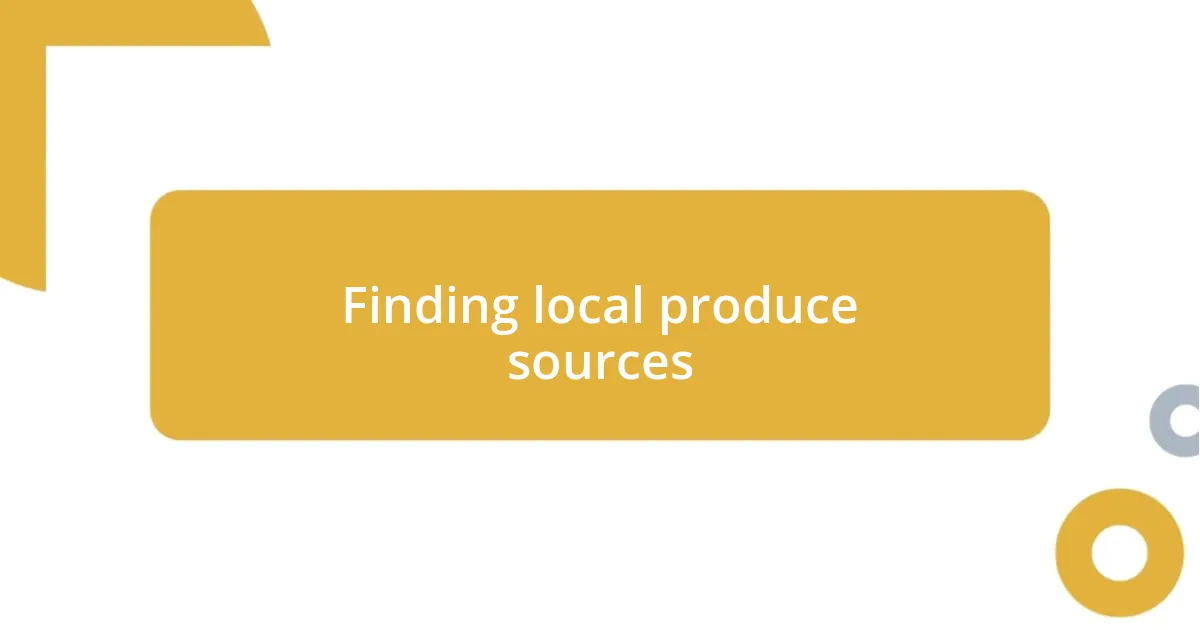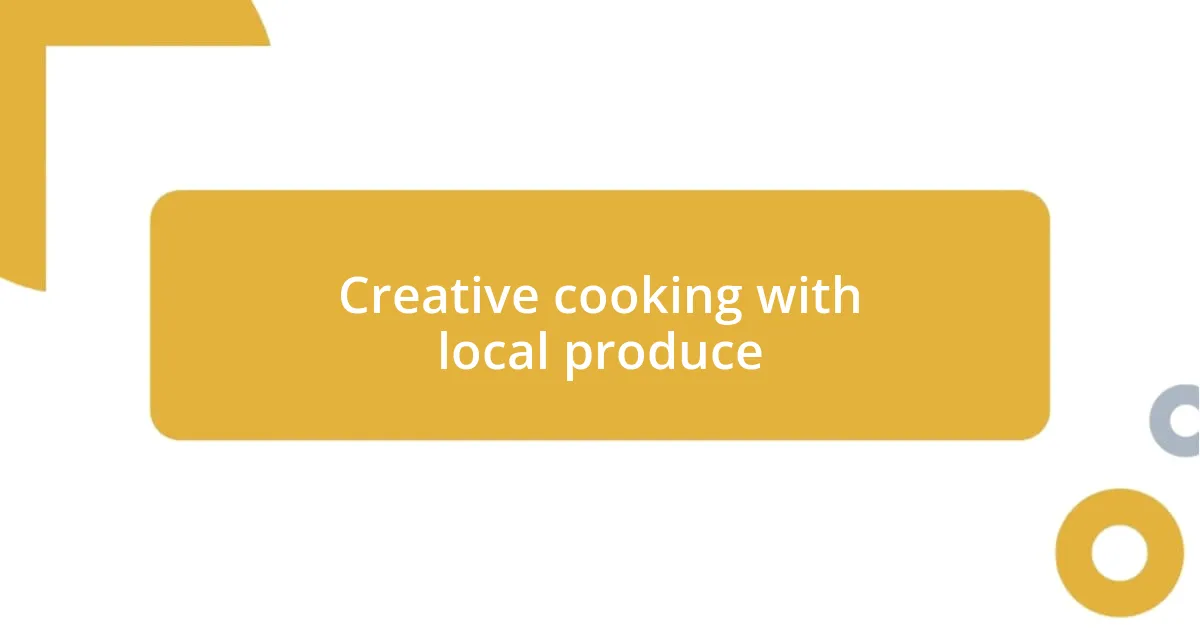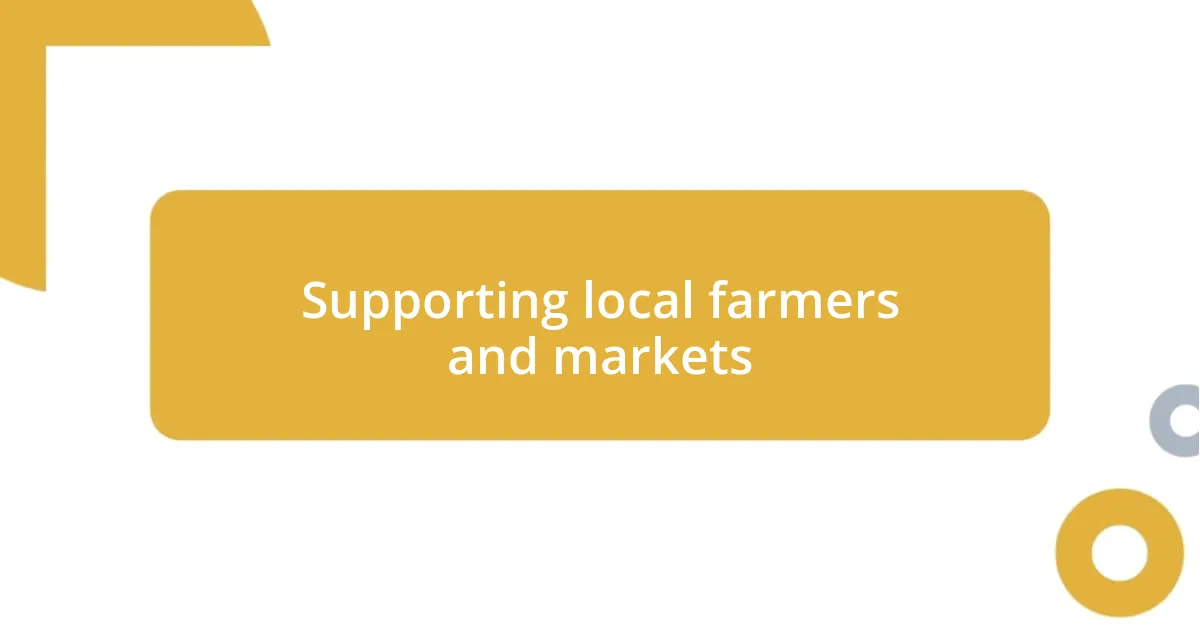Key takeaways:
- Choosing local produce fosters community connections, supports farmers, and preserves regional flavors.
- Seasonal ingredients enhance culinary experiences and promote sustainability by minimizing environmental impact.
- Meal planning around local produce encourages creativity and reduces food waste, making cooking more enjoyable.
- Supporting local farmers markets enriches meals and promotes awareness of sustainable practices within the community.

Understanding local produce benefits
When I think about local produce, I can’t help but feel a sense of connection to my community. Choosing fruits and vegetables grown nearby not only supports local farmers but also helps to preserve the distinct flavors of the region. Have you ever tasted a tomato that was picked just hours before hitting your plate? The difference in freshness is simply remarkable.
Moreover, local produce is often more nutritious. Since it doesn’t have to travel far, it’s typically harvested at peak ripeness, locking in essential vitamins and minerals. I remember the first time I sampled freshly picked strawberries from a farmer’s market. The sweetness was a revelation! It made me wonder, how much flavor have we lost by choosing those store-bought, travel-worn alternatives?
The environmental benefits are equally compelling. By purchasing local, we reduce the carbon footprint associated with transporting food across long distances. It’s an empowering choice—one that makes me feel like I’m contributing to a more sustainable future, even in a small way. Isn’t it comforting to know that our food choices can impact the planet positively?

Finding local produce sources
Finding local produce sources can be an adventure in itself. I remember the thrill of exploring my community’s farmer’s market for the first time. It felt like a treasure hunt, discovering vibrant colors and unique flavors all around me. Not only did I find fresh produce, but I also met the farmers who grew it. Engaging with them offered insights into their practices and allowed me to form a deeper bond with my food.
Here are some ways you can discover local produce sources in your area:
- Visit Farmers’ Markets: A great place to find fresh, seasonal fruits and vegetables while supporting local farmers.
- Join Community Supported Agriculture (CSA): By signing up, you receive a regular box of fresh produce from local farms.
- Explore Local Grocery Stores: Many have sections dedicated to local produce; look for labels indicating the source.
- Utilize Online Platforms: Websites and apps can connect you with local producers directly.
- Attend Agricultural Fairs: These events often showcase local farmers and their products while fostering a sense of community.
Digging deeper into my community revealed unexpected gems, like a small orchard just a few miles away. When I visited, walking among the rows of trees ripe with apples, I felt a profound appreciation for the work that goes into growing food. Connecting with nature and the farmers behind these crops adds an enriching layer to meal prep that store-bought produce can’t replicate.

Choosing seasonal ingredients
Choosing seasonal ingredients transforms meals into culinary experiences. I’ve noticed that when I shop with the seasons, my cooking evolves naturally, reflecting the rhythm of nature. For instance, when fall arrives, I lean toward hearty squash and earthy root vegetables. The first time I made a warm butternut squash soup, I could taste the season—it was like wrapping myself in a cozy blanket. How do you feel about using seasonal produce? To me, it’s not just about flavor; it’s about embracing the moment.
Seasonal ingredients are typically fresher, offering a burst of flavor that can’t be beaten. I vividly recall the joy of tasting ripe peaches in the summer—each one was like a mini celebration! It’s fascinating to learn how different seasonal fruits and vegetables pair with one another. One summer, I made a delightful salad with juicy peaches and peppery arugula, creating a harmony of flavors. Have you experimented with such combinations? Once you embrace the seasons, your meals become more vibrant and exciting!
Moreover, choosing seasonal produce is a smart strategy for sustainability. I once attended a local harvest festival where farmers showcased their seasonal offerings, educating attendees about the benefits of eating with the seasons. It struck me how this practice not only nourishes us but also supports local ecosystems. You can sense the energy of life in seasonal produce—it’s unmatched. And the beauty of this approach? It allows for creativity in the kitchen! I’ve come to appreciate how my meals tell the story of the seasons, connecting me with the earth and my local community.
| Season | Common Produce |
|---|---|
| Spring | Asparagus, Peas, Strawberries |
| Summer | Tomatoes, Zucchini, Peaches |
| Fall | Pumpkin, Apples, Brussels Sprouts |
| Winter | Kale, Root Vegetables, Citrus Fruits |

Integrating produce into meal planning
Integrating local produce into meal planning has genuinely transformed how I approach cooking. I often start my weekly meal prep by flipping through my favorite seasonal cookbooks, letting the ingredients available from local farms inspire me. For instance, I once found a beautiful bundle of fresh kale; it became the star of a nourishing soup that kept me warm during chilly evenings. What ingredients catch your eye when planning meals?
I also like to map out meals based on what’s fresh in my local market. Recently, I saw an abundance of summer tomatoes and basil, which sparked the idea for a simple yet delicious caprese salad. I could almost taste the sweetness of those tomatoes bursting in my mouth just thinking about it! This kind of planning not only fuels my creativity but also helps in minimizing food waste. Do you find it easier to stay organized when you let seasonal availability guide your meals? I certainly do.
Another effective method in my meal planning is batch cooking. When I find a great deal on local squash, I’ll roast a bunch and use it throughout the week, mixing it into various dishes. I remember how Halloween last year meant an influx of pumpkins; I roasted them, made soups, and even baked pies. Each bite carried a bit of that autumn magic. It’s amazing how planning around local produce can lead to meals filled with both flavor and warmth.

Creative cooking with local produce
Getting creative with local produce opens up a world of culinary possibilities that I absolutely love to explore. For instance, I had some colorful bell peppers and decided to stuff them with quinoa, black beans, and spices I had on hand. The first time I pulled them from the oven, the aroma that filled my kitchen was unforgettable. Have you ever created a dish that just felt like an inspired piece of artwork? That moment of satisfaction can be a game-changer.
I also enjoy experimenting with flavors that complement regional ingredients. One day, I had an abundance of fresh herbs—like cilantro and mint—thanks to my local farmer’s market. I thought, why not blend those into a homemade pesto? The result was a refreshing twist on a traditional recipe that I never expected to love so much. I still remember the surprise on my friends’ faces when they tasted it at dinner—everyone was eager for the recipe. Isn’t it amazing how local produce can spark such delightful creativity?
Another exciting aspect of cooking with local produce is the opportunity for impromptu meals. Just last week, I came home after a long day, and I found some beautiful zucchini and fresh mozzarella waiting for me. Without much thought, I decided to whip up a quick ratatouille. The ease of chopping vegetables and layering them in a pan made the process feel therapeutic. I often ask myself, how does cooking with local ingredients make me feel? There’s a calming simplicity in focusing on what’s fresh and available—it connects my kitchen to the land and creates a sense of belonging that I cherish deeply.

Supporting local farmers and markets
Supporting local farmers and markets not only enriches my meals but fosters a sense of community that I value deeply. Each time I visit my local farmers’ market, I feel a connection to the people behind my food. Last Saturday, I chatted with a farmer who was excited about his latest heirloom tomatoes—a conversation that turned my grocery run into a delightful experience. Doesn’t it feel wonderful to know exactly where your food comes from and who grew it?
I often reflect on how buying locally impacts the environment. When I choose to shop from nearby farms, I’m supporting sustainable practices that reduce carbon footprints. One day, I noticed a vendor selling free-range eggs, fresh from her own backyard. The thought of those chickens roaming freely made my breakfast feel like a small but meaningful act of kindness toward the planet. Have you considered how your food choices can promote sustainability in your community?
It’s not just about the food—it’s about the stories behind it. I remember one particular market day when I came across a small stand featuring honey from a local beekeeper. The sweetness of that honey was unlike anything I’d experienced, and it sparked a conversation about the importance of bees in our ecosystem. Sharing that moment with the beekeeper made me more aware of my impact on local agriculture. Isn’t it incredible how a simple trip to the market can open our eyes to broader issues?















